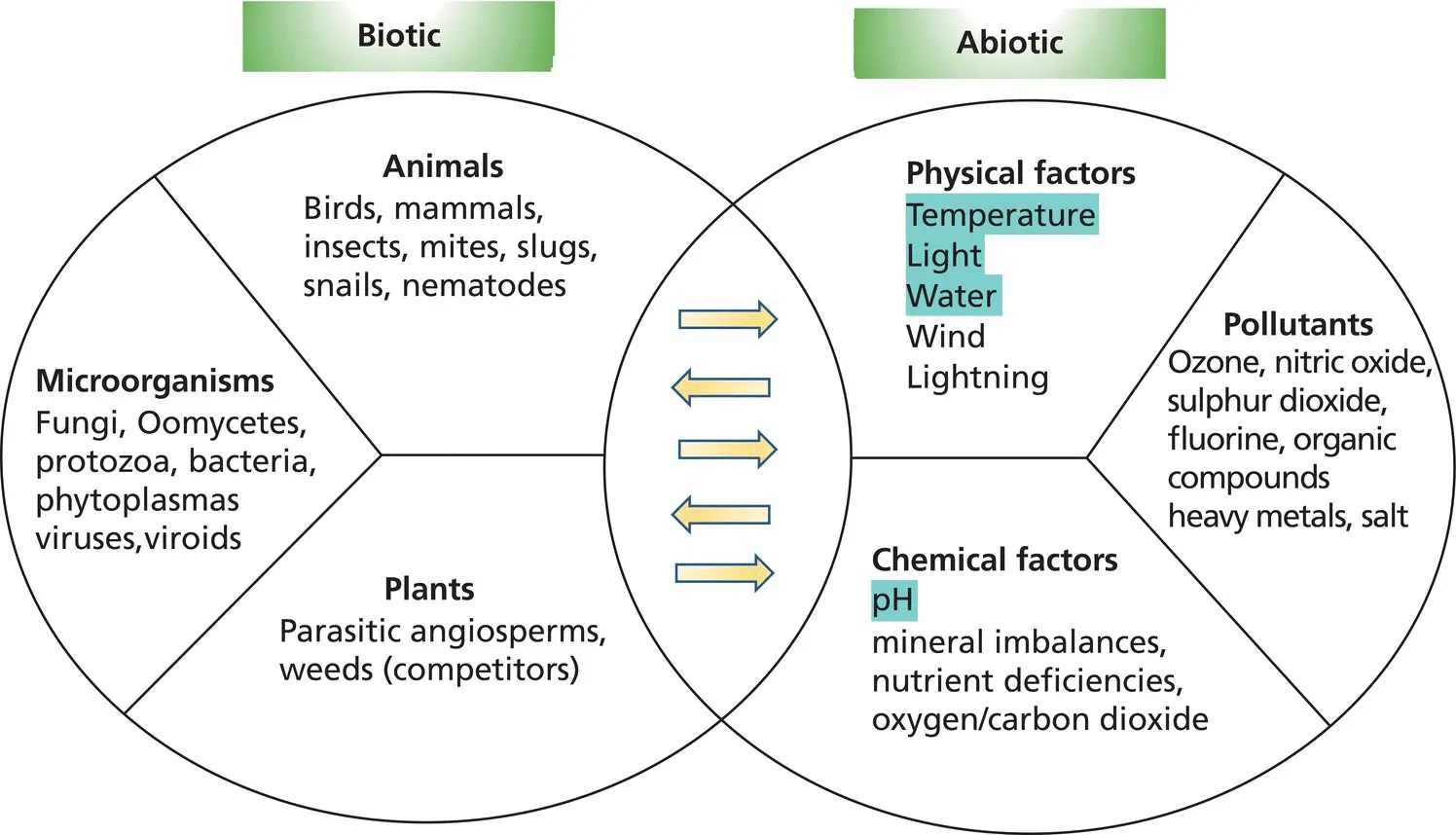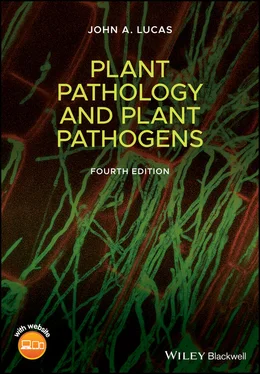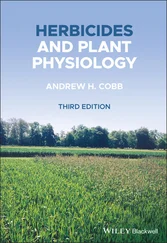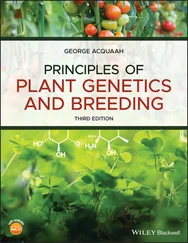1 ...6 7 8 10 11 12 ...19 While visual symptoms are still routinely used to diagnose diseases and disorders in crops growing in the field, in recent years a range of molecular assay techniques have become available to directly detect the agents causing the symptoms. Such molecular diagnostics are discussed in more detail in Chapter 4.
Any agent capable of adversely affecting green plants may be regarded as lying within the scope of plant pathology. The principal agents involved in plant disease are shown in Figure 1.5. Partial or total crop failure may be due to one or more agents. Where more than one agent is responsible, each may act independently, or they may interact. In the latter instance, there may be synergism, that is, two or more agents acting in combination to cause symptoms that are more severe than those produced by either agent alone. Synergism has been demonstrated to occur with several combinations of viruses. For example, tobacco mosaic virus and potato virus X each cause relatively mild mottling symptoms in tomato. But if by chance they both occur together in the same host, then severe necrosis develops and this may even result in the death of the plant.
A useful distinction can be drawn between animate ( biotic) and inanimate ( abiotic) causes of disease ( Figure 1.5). Many of the animate agents, including the microbial pathogens, the parasitic angiosperms, and some of the animal pests, are infectious. Due to their capacity for growth, reproduction, and dispersal, these agents spread from one host plant to another. Under particularly favorable conditions, they may be dispersed rapidly over wide areas and even entire continents.
Among the animals exploiting plants are many pests which cause damage to roots, leaves, shoots, flowers, and fruits. Usually these pests, which include insects such as aphids and leafhoppers, and some nematodes, spend relatively brief periods on individual plants before moving on to explore new food supplies. Other pests, such as leaf miners, gall‐forming sawflies, and endoparasitic nematodes, spend their entire life cycle, or a major part of it, on one plant. Pest attack may result simply in a drain on host nutrients or, alternatively, in extensive destruction of tissues. Aphids and whiteflies on leaves and stems extract sap from the phloem with almost clinical efficiency. Many caterpillars are simply small herbivores; nevertheless, they can consume large areas of the leaf lamina.

Figure 1.5 Agents responsible for plant disease, disorders, and damage. Highlighted factors are damaging when extremes occur.
Other pests cause more complex host responses or symptoms. Developing gall wasp larvae induce the formation of morphologically characteristic and often pigmented galls on leaves, while nematodes such as Meloidogyne spp. cause swellings, termed “knots,” on the roots of tomatoes and potatoes. When these root‐knot nematodes and the related endoparasitic cyst nematodes penetrate root tissues, host cells adjacent to the vascular system become enlarged and provide a specialized feeding site where nutrients are transferred to the sedentary worm. Such pests often show highly specialized adaptions to their respective hosts and, conversely, the plants mount defense reactions in response to attack which are similar to those induced by pathogenic microorganisms. Nematodes are of particular importance in the tropics where they damage numerous crop species, but some are also serious pests on temperate crops; for instance, cyst nematodes are the number 1 pest problem on potatoes in the UK and have infested around two‐thirds of the land on which the crop is grown.
Larger animals such as birds or mammals can also be destructive pests. Winter grazing by rabbits can seriously reduce the final yield of autumn‐sown crops such as wheat and oilseed rape. In Europe, pigeons also cause damage to oilseed rape, while in parts of Africa flocks of seed‐eating finches, such as Quelea , are a major threat to crops of sorghum and millet.
Parasitic Plants and Weeds
Higher plants may cause disorders of or damage to other plants, either by acting directly as parasites diverting nutrients and water or as vigorous competitors or antagonists within mixed populations. Parasitic angiosperms are rare enough to be curiosities in many cool temperate countries, but elsewhere they are nuisances or economically important parasites ( Table 1.2, Figure 1.6). The dwarf mistletoes, Arceuthobium , can kill or deform pines and other conifers, and even minor attacks reduce the quality of timber by causing the production of numerous large knots and irregularly grained, spongy wood. These parasites spread their sticky seeds by an explosive dispersal mechanism, leading to patches or foci of infestation within a plantation. By contrast, root parasites such as Orobanche and witchweed, Striga , produce numerous tiny seeds which lie dormant in the soil. The seeds are triggered to germinate by a stimulant from host roots. The parasite then attaches itself to the root by means of a specialized organ and diverts water and nutrients, leading to wilting, chlorosis, and stunting of the host. These parasites are difficult to control due to the large number of seeds they produce (in the case of Striga , as many as 200 000 per plant) and the long periods over which they remain viable.
On a world scale the most important angiosperm parasite is Striga hermonthica which attacks cereals such as maize, sorghum, millet, and rice. In many of the agricultural areas where it is most prevalent, for example sub‐Saharan Africa, there are insufficient resources to support expensive control measures and infested land may eventually be abandoned. Recently, cultivation systems have been developed that reduce Striga infestation by intercropping the cereal host with a different crop, usually a legume, that suppresses infection by the parasite (see later in this chapter). Orobanche is a significant problem in sunflower, tobacco, tomato, and especially faba bean, with a substantial proportion of the crop area in the Mediterranean region affected.
Table 1.2 Angiosperms parasitic on other higher plants
| Family, common name, genus |
Geographic area |
Crops attacked |
| Convolvulaceae Dodder ( Cuscuta ) |
Europe, North America |
Alfalfa, clover, potatoes, sugar beet |
| Lauraceae Dodder ( Cassytha ) |
Tropics and subtropics |
Citrus trees |
| Loranthaceae Dwarf mistletoe ( Arceuthobium ) |
Worldwide |
Gymnosperms |
| American true mistletoe ( Phoradendron ) |
North America |
Angiosperm trees |
| European true mistletoe ( Viscum ) |
Europe |
Angiosperm trees, especially apple |
| Orobanchaceae Broom rape ( Orobanche ) |
Europe |
Tobacco, sunflower, beans |
| Scrophulariaceae Witchweed ( Striga ) |
Africa, Asia, Australia, North America |
Maize, sorghum, rice, cowpea |
The deleterious effects of other higher plants are due to competition for space, light, water, and nutrients. Species which are vigorous competitors with crop plants are usually described as weeds. As well as affecting crop development, weeds may interfere with harvesting and their seeds can contaminate grain samples. They may also be important as alternative hosts for pests or pathogens which can subsequently spread to crops. In addition to direct competitive effects, some plants produce chemicals which inhibit the growth of neighboring plants. This phenomenon, analogous to microbial antibiosis, is known as allelopathy. Plant roots release a diverse range of chemicals which can act as potential inhibitors or defense compounds, but it is difficult to determine the extent to which these interactions operate in nature. Allelopathy is believed to influence plant succession and distribution in natural communities, and may also have significant effects in agricultural systems. The chemicals involved are of interest both as potential herbicides and as signal molecules affecting the growth and behavior of other organisms. The suppression of Striga by some legumes, described earlier, has been shown to be due to a combination of compounds that stimulate “suicidal germination” in the absence of the host and inhibitors that interfere with infection of roots.
Читать дальше












